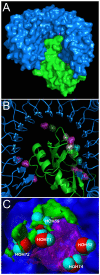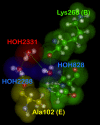Bound water at protein-protein interfaces: partners, roles and hydrophobic bubbles as a conserved motif
- PMID: 21961043
- PMCID: PMC3178540
- DOI: 10.1371/journal.pone.0024712
Bound water at protein-protein interfaces: partners, roles and hydrophobic bubbles as a conserved motif
Abstract
Background: There is a great interest in understanding and exploiting protein-protein associations as new routes for treating human disease. However, these associations are difficult to structurally characterize or model although the number of X-ray structures for protein-protein complexes is expanding. One feature of these complexes that has received little attention is the role of water molecules in the interfacial region.
Methodology: A data set of 4741 water molecules abstracted from 179 high-resolution (≤ 2.30 Å) X-ray crystal structures of protein-protein complexes was analyzed with a suite of modeling tools based on the HINT forcefield and hydrogen-bonding geometry. A metric termed Relevance was used to classify the general roles of the water molecules.
Results: The water molecules were found to be involved in: a) (bridging) interactions with both proteins (21%), b) favorable interactions with only one protein (53%), and c) no interactions with either protein (26%). This trend is shown to be independent of the crystallographic resolution. Interactions with residue backbones are consistent for all classes and account for 21.5% of all interactions. Interactions with polar residues are significantly more common for the first group and interactions with non-polar residues dominate the last group. Waters interacting with both proteins stabilize on average the proteins' interaction (-0.46 kcal mol(-1)), but the overall average contribution of a single water to the protein-protein interaction energy is unfavorable (+0.03 kcal mol(-1)). Analysis of the waters without favorable interactions with either protein suggests that this is a conserved phenomenon: 42% of these waters have SASA ≤ 10 Å(2) and are thus largely buried, and 69% of these are within predominantly hydrophobic environments or "hydrophobic bubbles". Such water molecules may have an important biological purpose in mediating protein-protein interactions.
Conflict of interest statement
Figures












Similar articles
-
Mapping the energetics of water-protein and water-ligand interactions with the "natural" HINT forcefield: predictive tools for characterizing the roles of water in biomolecules.J Mol Biol. 2006 Apr 21;358(1):289-309. doi: 10.1016/j.jmb.2006.01.053. Epub 2006 Feb 2. J Mol Biol. 2006. PMID: 16497327
-
On the contribution of water-mediated interactions to protein-complex stability.Biochemistry. 2008 Jan 22;47(3):1051-60. doi: 10.1021/bi7019639. Epub 2007 Dec 28. Biochemistry. 2008. PMID: 18161993
-
Energetics of the protein-DNA-water interaction.BMC Struct Biol. 2007 Jan 10;7:4. doi: 10.1186/1472-6807-7-4. BMC Struct Biol. 2007. PMID: 17214883 Free PMC article.
-
Computational and structural characterisation of protein associations.Adv Exp Med Biol. 2012;747:42-54. doi: 10.1007/978-1-4614-3229-6_3. Adv Exp Med Biol. 2012. PMID: 22949110 Review.
-
Significant role of electrostatic interactions for stabilization of protein assemblies.Adv Biophys. 1997;34:41-54. doi: 10.1016/s0065-227x(97)89630-x. Adv Biophys. 1997. PMID: 9204125 Review.
Cited by
-
Three-Dimensional Interaction Homology: Deconstructing Residue-Residue and Residue-Lipid Interactions in Membrane Proteins.Molecules. 2024 Jun 14;29(12):2838. doi: 10.3390/molecules29122838. Molecules. 2024. PMID: 38930903 Free PMC article.
-
Anchor extension: a structure-guided approach to design cyclic peptides targeting enzyme active sites.Nat Commun. 2021 Jun 7;12(1):3384. doi: 10.1038/s41467-021-23609-8. Nat Commun. 2021. PMID: 34099674 Free PMC article.
-
Statistical analysis of sequential motifs at biologically relevant protein-protein interfaces.Comput Struct Biotechnol J. 2024 Mar 7;23:1244-1259. doi: 10.1016/j.csbj.2024.03.004. eCollection 2024 Dec. Comput Struct Biotechnol J. 2024. PMID: 38550974 Free PMC article.
-
Antibody CDR amino acids underlying the functionality of antibody repertoires in recognizing diverse protein antigens.Sci Rep. 2022 Jul 22;12(1):12555. doi: 10.1038/s41598-022-16841-9. Sci Rep. 2022. PMID: 35869245 Free PMC article.
-
Rational Design of a User-Friendly Aptamer/Peptide-Based Device for the Detection of Staphylococcus aureus.Sensors (Basel). 2020 Sep 2;20(17):4977. doi: 10.3390/s20174977. Sensors (Basel). 2020. PMID: 32887407 Free PMC article.
References
-
- Zacharias M. 400 p; 2010. Protein-protein complexes: Analysis, modeling and drug design: Imperial College Press.
-
- Arkin MR, Wells JA. Small-molecule inhibitors of protein-protein interactions: Progressing towards the dream. Nat Rev Drug Discov. 2004;3:301–317. - PubMed
-
- Wilson AJ. Inhibition of protein-protein interactions using designed molecules. Chem Soc Rev. 2009;38:3289–3300. - PubMed
-
- Betzi S, Guerlesquin F, Morelli X. Protein-protein interaction inhibition (2P2I): fewer and fewer undruggable targets. Comb Chem High Throughput Screen. 2009;12:968–983. - PubMed
Publication types
MeSH terms
Substances
Grants and funding
LinkOut - more resources
Full Text Sources

